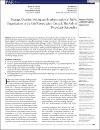Strategic Decision Making and Implementation in Public Organizations in the Gulf Cooperation Council: The Role of Procedural Rationality
Date
2022Metadata
Show full item recordAbstract
Based on Herbert Simon's conceptualization of bounded rationality, this article develops and tests an integrative model of the strategic decision-making process (SDMP) and outcomes in public organizations. The model integrates different SDMP dimensions—procedural rationality, intuition, participation, and constructive politics—and examines their impacts on the successful implementation of strategic decisions. Additionally, it analyzes the influence of implementation on the overall outcomes of strategic decisions. The model was tested with data from multiple sources on 170 strategic decisions collected from senior executives working in 38 public organizations in Qatar—a context in which studies on decision making are rare. With the exception of intuition, this study shows a positive impact of all SDMP dimensions on the successful implementation and outcomes of strategic decisions. Successful implementation fully mediates the relationships between procedural rationality, participation, and constructive politics and the outcomes of strategic decisions. Evidence for Practice: The study shows how managers decide on strategic issues for public organizations. There is a positive relationship between procedural rationality, participation, and constructive politics and the successful implementation of strategic decisions. Public managers can influence the success of strategic decisions by establishing formal processes to ensure that all relevant information is collected and analyzed and that people with experience and diverse perspectives participate in decision making. Developing effective implementation processes is necessary for improving the outcomes of strategic decisions in public organizations.
Collections
- Center for Entrepreneurship Research [144 items ]


